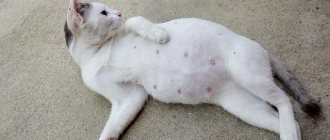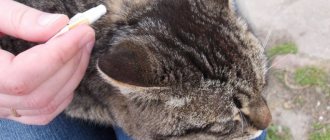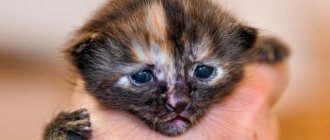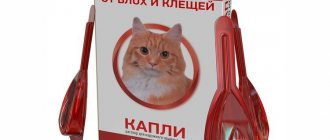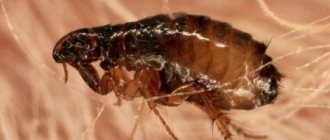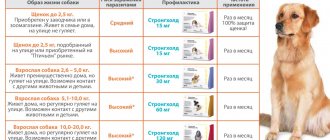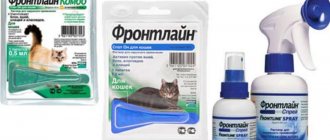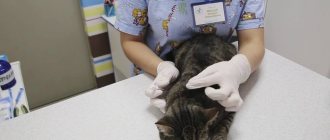Many pet cat owners are familiar with the problem of fleas appearing in their pet's fur. These blood-sucking insects not only cause serious discomfort to the animal, but can also carry dangerous diseases. The more fleas there are, the higher the risk of an allergic reaction, dermatitis or infection. Therefore, you need to learn how to detect these parasites in time and know how to get rid of them.
Fleas are common blood-sucking insects that live in animal fur. These parasites have a flattened body, thanks to which they easily move in the fur. Capable of jumping high - up to 30 cm. They bite through the skin and feed on the pet's blood, usually living on the stomach, near the ears - in those places where the skin is thinner.
What is better for fleas: drops or a collar?
Let’s immediately decide what is better for fleas: drops or a collar. Misconceptions in this matter drive many owners to despair. The fact is that the collar itself is an additional preventive measure. Putting a collar on a flea-infested kitten will not get rid of parasites!
The collar is used as a measure of additional protection, not even against fleas, but against ticks. After treatment with drops, the collar serves as a means of repelling new parasites. In addition, wearing a flea collar before the recommended age can lead to stunted growth and development.
Prevention
To prevent the appearance of fleas in a cat, you can use some of the remedies listed above. For example, periodic washing with shampoo and soap or wearing a special collar.
In addition, it is necessary to take into account that the sleeping place of an infected animal (bedding, floor, carpet) is also inhabited by parasites. Therefore, the cat should be treated and its bed disinfected at the same time. This is important to prevent the risk of re-infection.
Disinfection of the premises where the animal lives is also mandatory. It can be done using special products sold in pet stores. It is necessary to treat not only the floor, but also upholstered furniture, curtains, and baseboards. If it is difficult to do this yourself, then it is worth inviting disinfection specialists.
Among the folk recipes for prevention, you can use the effective method of repelling insects with wormwood. To do this, place dry or fresh branches of the plant under the bedding on the sleeping area.
On a note
: washing the floor with a strong decoction of wormwood will help prevent the appearance of parasitic insects in an apartment or private house if treating the floor with disinfectants is impossible for some reason. For example, if there is an allergy sufferer in the family or a baby who is still learning the world at a crawl.
Fleas on a cat are not forever. This problem can and should be solved promptly, without leading to serious ailments. Experienced veterinarians at the Jungle Clinic will help treat your four-legged pet, regardless of the severity of the clinical case.
How do flea drops work?
Many owners are interested in how flea drops work. The mechanism of action of the drug depends on the active ingredients. Common flea drops eliminate parasites in several ways:
- Disturbance of nervous activity - the flea drinks blood, after which paralysis and death occurs.
- Contact action - the poison penetrates the body of the parasite through direct contact.
- Repellent effect - some flea drops do not kill, but only repel parasites with their smell.
Important! The duration of action depends on the type of active ingredients and their dosage. Most often, drops protect a cat from fleas for 8 weeks, and from ticks for 4 weeks.
How often should I treat my kitten for fleas?
How often do you treat a kitten for fleas as a preventive measure? According to generally accepted rules, preventive treatment against parasites is carried out quarterly. The period is considered optimal to interrupt the reproduction cycle of most parasites.
If a cat is infested with fleas, treatment is carried out outside the schedule. If infection is repeated, it is recommended to change the drops, since their protective effect should protect the kitten from 4 to 8 weeks (depending on the drug). Shampoos and some flea sprays do not have a prolonged action, that is, they kill fleas “here and now,” but the very next day the kitten can “pick up” fleas again.
Pay attention! If infected with subcutaneous mites, as prescribed by a veterinarian, treatment may be carried out more often.
When can you wash your kitten after applying the drops?
When can I wash my kitten after flea treatment? Typically, this information is indicated in the instructions for the drops. The absorption time of the drops depends on the base of the drug. oil drops cannot be washed off for 4–5 days; water-based preparations are absorbed faster, in 1–2 days.
The kitten should be bathed immediately if it has a local reaction to the use of drops. Symptoms of an allergic reaction include: redness, itching, swelling, and the appearance of fresh scratches. In rare cases and in case of overdose, the kitten may experience a reaction from the nervous system: drooling, convulsions, apathy.
Instructions: how to apply flea drops
Each package of drops contains instructions on how to give the kitten the drops. The instructions indicate indications and contraindications that must be studied first. Typically, the contraindications section indicates the minimum permissible age for processing.
The generally accepted rules for treating animals against fleas using drops include:
- The product is applied to intact, dry skin.
- Drops are applied to the back of the head or shoulder blades, so that the kitten does not reach the treated areas while washing.
- During the first hours after treatment, the kitten must be closely monitored as side effects may occur.
- If you are unable to ensure that the kitten does not lick the drops, you need to put an Elizabethan collar on it.
When treating kittens, it is not recommended to use products whose dosage is designed for large weights, for example 1 ml per 10 kg of body weight.
In addition, it is strictly not recommended to use drugs intended for dogs when treating cats.
At what age can the drops be used?
At what age can a kitten be treated for fleas? It all depends on the product you choose and its active ingredients. Most drugs are not recommended for use on kittens under 4 weeks of age. Even those drops that can be used to treat pregnant and lactating females are most often contraindicated in kittens.
If your pet has given birth to kittens and all animals are infected with fleas, it is necessary to treat the cat. Some approved products, for example, Advantage, protect the cat and the entire litter from fleas. If you pick up a kitten on the street and suspect that it is less than 4 weeks old, but is already infected with fleas, you need to use folk remedies or select fleas manually.
What affects the effectiveness of drops?
Success in flea control depends on the appropriate dose of medication and following safety precautions. Cleanliness in the house where a kitten lives plays a vital role in maintaining its health. It is necessary to treat not only the pet itself with flea remedies, but also the entire room. When the parasites disappear from the home, there will be no sources of infection left, which means the cat will be reliably protected from parasites.
The room can be sprayed with anti-flea spray. But a more noticeable effect will come from washing the floors with flea repellent. A small amount of the drug should be diluted in a bucket of water and the floors should be washed with this liquid.
Attention! After treating the floors in the apartment, you must carefully ensure that cats do not pick up anything from the floor or lick it.
How to rid a kitten of fleas without using medications
If the kitten cannot be treated with traditional flea drops, parasites can be removed using folk remedies. Using safe methods takes time and diligence. Ultimately, the parasites are removed manually by combing out.
Important! If a kitten has a severe flea infestation, it is better to consult a veterinarian who will assess the risks and potential medicinal effect of certain medications.
Common folk remedies for removing fleas are:
- A decoction of wormwood, tansy and eucalyptus.
- Natural apple cider vinegar.
- Infusion or decoction of fresh pine needles.
- Citrus infusion.
All of the above products have an unpleasant odor, which irritates and repels parasites. It is important to understand that the smell of apple cider vinegar and citrus fruits will be extremely unpleasant to the kitten. An animal may have an allergic reaction to a decoction of herbs.
At 1 month of age, kittens cannot be treated for fleas with traditional products. Absolutely all drops are toxic and can adversely affect the baby’s nervous system. At such a young age, a kitten can only be rid of fleas by hand.
To comb out parasites, you need a fine-tooth comb and your patience. To prevent fleas from biting and jumping off the kitten onto the floor, it is better to comb the fur with water and lemon juice. After the procedures, it is not recommended to bathe the kitten!
At 2 months
At 2 months (8 weeks), a kitten can be rid of fleas using drops. Almost all products can be used from 8 weeks. However, some drops are strongly recommended to be used only under medical supervision.
At the age of two months, the kitten can be bathed using anti-flea shampoos. Naturally, when using shampoos, you must follow safety precautions and thoroughly rinse the product from your pet’s fur. Until the kitten is dry after bathing, it must be protected from drafts and ensure that it does not lick itself.
How to bathe a cat or kitten
Before starting this procedure, you need to take into account that both small kittens and adult cats are often afraid of water procedures, and bathing is very stressful for them (although there are exceptions when they love to squish in the water and even jump into the washbasin for a bath).
How to wash a kitten with flea shampoo - sequence of steps:
Prepare: a small basin and a bottle of shampoo; The water should be warm (in no case hot); Place the baby in the basin, holding it with one hand (so as not to run away) and thoroughly moisten the fur;
When washing, do not allow water or anti-flea shampoo to get into the cat's ears or eyes to avoid irritation.
My daughter and I found a small and very flea-covered beautiful cat in the yard and brought it home. The first item on the agenda was flea removal. We bought an inexpensive special shampoo and performed water treatments that same evening. There were a lot of screams and fleas too, and then they combed them out by the dozens. A week later, the treatment was repeated, since there were still several unkilled individuals left. And now we live with a clean and well-groomed fluffy beauty, whom my daughter loves very much.
Side effects
All prophylactic drugs intended to combat parasites are toxic. Drops released for treating kittens are usually classified as moderately toxic substances. It is important to understand that the conditional safety of the drops implies exclusively external use and the absence of an individual allergic reaction.
If you are treating a kitten with an unknown medical history, you should use the safest possible drops and consult your veterinarian first. In most cases, kittens picked up on the street or bought at a poultry market are infected not only with fleas, but also with worms. In case of mixed invasion, it is much more reasonable to use complex drugs (for external and internal parasites) in the form of drops.
Kitten itches after flea drops
In rare cases, if there is an individual intolerance to the active ingredients of the drops, the animal may experience an allergic reaction. If the kitten itches after flea drops, it is necessary to inspect the treatment area. Alarming symptoms are: redness, swelling and local fever. If you notice symptoms of an allergic reaction, the remaining droplets must be washed off from the kitten’s fur and skin.
In the absence of an allergic reaction, after treatment with drops, the kitten may itch during the day. The fact is that most drops quickly paralyze fleas, but the death of parasites can occur within several hours. An allergic reaction to already inflicted flea bites can last up to 12–20 hours. In addition, gentle drugs can only affect adults. In this case, the treatment is repeated after 4–10 days (according to the instructions or prescription of the veterinarian).
The kitten licked the drops and became poisoned - what to do?
What to do if the kitten licked the drops and got poisoned? Generally recognized symptoms of poisoning are: drooling, apathy, decreased body temperature, nausea and vomiting . If such symptoms are observed in a pet, it is necessary to immediately give it absorbent agents.
Monitor the dynamics carefully and provide your pet with plenty of warm drink. If symptoms worsen or your kitten develops tremors or seizures, contact your veterinarian immediately! In case of overdose or poisoning with flea drops, the kitten can die in a matter of hours.
Ways to prevent itching in animals
Simple rules will help protect your cat from itching:
- It is necessary to wash the bedding once a month, wash the dishes daily, and buy high-quality food enriched with vitamins and minerals that will support the immune system.
- If your pet walks outside, wear a flea collar and use drops and shampoos.
- Be sure to keep your cats ears clean.
You should not immediately think that the cat is itching from drops: this is masking a more serious disease. If he does not have fleas, but the animal is itching, do not delay a visit to the veterinarian, this will protect the cat from damage to the skin and prevent serious infection.
https://meowkiss.ru/kogda-mozhno-pomyt-kotenka-posle-kapel-ot-blox/ https://apest.ru/blohi/blohi-u-koshek/koshka-cheshetsya-posle-kapel-ot- bloh/
Review of popular flea drops - application, indications and contraindications
Never believe what it says on the label! That’s right, if the drops say “for kittens,” most likely we are talking about animals older than 2–3 months. For reference, animals under 9–12 months of age are also considered kittens, so manufacturers do not lie when they place colorful labels on packages.
Important! There are no absolutely safe flea drops. Always read the instructions before use! If you have any doubts about the safety of the drug, it is better to consult a veterinarian.
The drug differs from most drops in the number of components. The main active ingredients of Bars drops are:
Interacting, the active substances give a relatively good result, against the background of low toxicity. Once in the body of parasites, the active substances disrupt the functioning of their nervous system, which quickly leads to paralysis, and within 2-4 hours to death. In addition, Bars drops have a detrimental effect not only on adult parasites, but also on their eggs. Simply put, drop treatment interrupts the flea reproduction cycle, and this is very important at any stage of the infestation.
Indications for use: elimination of skin parasites, including fleas, lice, lice, subcutaneous and pasture ticks in animals older than 2 months.
Contraindications to the use of Bars drops:
- Individual intolerance.
- Acute allergic reactions.
- Immunocompromised animals: dehydrated, malnourished, sick or recovering from illness.
- Carriers of a viral infection.
- Kittens under 8 weeks and cats over 12 years old.
- When treating ear mites, the use of drops in case of perforation of the eardrum is not recommended.
According to the manufacturer, the active ingredients are distributed throughout the deep layers of the skin without penetrating into the systemic bloodstream. When used externally, the drug is considered moderately toxic, but drops must be used observing all safety precautions. Upon contact with mucous membranes, the active ingredients of Bars drops cause irritation; if swallowed, the toxicity of the drug increases sharply.
The recommended dosage is as follows:
- Cats weighing up to 1 kg – 0.3 ml.
- Cats weighing 1–3 kg – 0.6 ml.
- Cats weighing more than 3 kg – 1 ml.
Important! Drops are applied only to dry, intact skin.
According to the manufacturer, Celandine drops can be used to prevent and treat infestations of skin parasites in kittens and adult cats. The residual effect of the drug lasts up to 2 months against fleas and up to 1 month against pasture ticks.
The active ingredients of Celandine drops are:
The range of the drug is aimed at combating external parasites: fleas, lice, lice and ticks. In addition, Celandine is prescribed for the treatment of subcutaneous mites. According to the manufacturer, the composition of the drops helps to effectively fight parasites at different stages of growth (from egg to mature individual). The active ingredients of the drops disrupt nerve conduction in parasites, which leads to their paralysis and death.
Contraindications to the use of Celandine drops:
- Kittens under 8 weeks old.
- Cats over 12 years old.
- Animals suffering from liver and kidney pathologies.
- Virus carriers.
- Weakened, emaciated, dehydrated animals.
- Animals that are sick or recovering from illness.
Note! When used externally in recommended doses, the drug is classified as moderately dangerous. Upon contact with mucous membranes, the active substances cause severe irritation. When licked and swallowed, drops can lead to both local reactions (salivation, allergies) and poisoning.
The dosage of Celandine drops is calculated by the weight of the animal:
- For cats weighing up to 2 kg – 0.5 ml.
- For cats weighing over 2 kg – 1 ml.
The drug is applied to healthy, dry skin, dropwise along the ridge. The place where the drops are applied should be inaccessible for licking. For preventive purposes, after applying the drops, you need to monitor the kitten or use an Elizabethan collar.
Stronghold
Stronghold drops contain only one active ingredient – selamectin. At the same time, the effect of the substance is complex, eliminating:
- Fleas, lice, lice.
- Subcutaneous mites, including scabies.
- Pasture ticks.
- Heartworms - dirofilaria.
- Intestinal worms at all stages of development.
Drops are indicated for the treatment and prevention of the above parasites in healthy animals older than 6 weeks. Stronghold is approved for use for prophylaxis in pregnant and lactating females. When weakened and sick animals are infected, prophylaxis is carried out only under the supervision of a veterinarian.
Note! Stronghold drops are valid for 1 month from the date of application.
Drops are applied along the spine, directly to the skin, from the back of the head to the shoulder blades. The skin should be dry and healthy. Dosage depends on weight:
- Kittens and cats weighing up to 2.5 kg – 15 mg (purple dropper).
- Adult cat weighing up to 7.5 kg – 45 mg (blue pipette).
Inspector
To eliminate infestations in cats, Inspector drops from the Total K series are used. The drug has a complex effect and eliminates external and internal parasites at all stages of development.
Active ingredients:
According to the manufacturer, the spectrum of action of the drug includes 14 types of parasites, including:
- Ixodid ticks.
- Scabies mites.
- Fleas.
- Lice, lice eaters.
- Nematodes are intestinal parasites.
- Dirofilariae are heartworms.
Note! The effect of Inspector drops lasts up to 2 months from the moment the pet is treated.
Inspector drops are indicated for the treatment and prevention of the above parasites in healthy animals weighing more than 1 kg. The dosage of the drug is the same - 1 pipette; if necessary, the contents of the pipette are divided. For cats weighing more than 8 kg, the dosage is calculated individually. Treatment is carried out only under the supervision of a doctor if the cat:
- Weighs less than 1 kg.
- Pregnant or nursing offspring.
- Exhausted or dehydrated.
- Sick or recovering from an illness.
- Over 10–12 years old.
- Has chronic pathologies.
Important! Inspector drops are contraindicated for kittens under 7 weeks of age!
Advantage
Advantage drops are available in two dosages: “40” and “80”, for cats weighing up to and over 4 kg, respectively. There is only one active ingredient – imidacloprid. The spectrum of action of the drug applies only to fleas.
The advantages of the drug include:
- Quick action - fleas are paralyzed or die before they can bite the cat.
- Water resistance - drops protect your pet even if it gets caught in the rain.
- Distribution throughout the coat - drops are not absorbed into the bloodstream. In addition, the drug destroys fleas not only on the cat, but also in its resting places.
Note! The protective effect of Advantage drops lasts up to 4 weeks.
The drug is used for the treatment and prevention of fleas in healthy animals. Advantage is safe for pregnant and lactating females. In addition, after treating the young mother, the kittens will be protected from fleas. Kittens should not be handled until they are 8 weeks old.
Note! According to the manufacturer, the drug is completely safe for people, however, it is strongly recommended to follow safety precautions during processing!
Beaphar
To treat kittens, Beafar drops from the Bio series are used. The drops contain three types of oils, but the active one is margosa extract. The drops are considered natural and safe, but they do not kill parasites, but repel them.
The protective effect of the drops lasts for 4 weeks from the moment of application.
With Beafar Bio drops you can protect your kitten from:
Note! When using Beafar drops, in rare cases, kittens experience a local allergic reaction - itching, redness, swelling. If suspicious symptoms are detected, the skin and fur should be washed with kitten shampoo.
Drops are used to treat healthy kittens over 12 weeks of age. The contents of the pipette are applied along the spine, from the back of the head to the shoulder blades, onto dry, healthy skin. The drug is strictly not recommended for use on weakened kittens that are lagging behind in weight gain and development.
Flea drops are a convenient form of the drug that is easy to apply and effectively destroys parasites, extending protection up to 1-2 months. But the use of the product has its own subtleties that need to be studied in detail before purchasing and using.
How do flea drops work?
Drops are a unique way of protection. Just a few drops applied to the animal’s withers in the first hours cause the death of all adult individuals, and after a while they destroy the remains of the parasites and their hatched eggs.
The principle of action of the drops is that insecticidal substances quickly spread throughout the animal’s body without entering the bloodstream. This makes the drug safe.
The product contains active components in different ratios. The dosage depends on the age and weight of the pet - there are separate preparations for adult cats and for babies. It is important to follow the instructions and not apply more of the drug than required. Failure to comply with the rules may lead to intoxication of the cat.
All components included in the drops cause paralysis of fleas. Be sure to check before purchasing exactly what phases of parasite development the product affects. There are drugs that destroy adult individuals, and others that prevent the hatching and development of larvae.
The great advantage of the protection method is that the drugs have a complex effect, affecting fleas and other parasites - lice, lice, ticks. But often a different scheme is used to treat an animal from them - which is why it is so important to carefully study the instructions before use.
Universal sprays
In addition to fleas, our pets are susceptible to attack by another parasite – ticks, which is quite a serious problem for owners. These blood-sucking insects, in addition to unpleasant bites that become inflamed and itchy, are very dangerous to health. They are known as carriers of various diseases, including fatal ones. Therefore, from early spring it is necessary to pay special attention to this issue in order to prevent dangerous situations.
You can cope with this problem with the help of universal sprays that have a wide range of actions. They contain special substances that have a detrimental effect on both fleas and ticks. Regarding the opinion of the owners, reviews indicate that it is these sprays that are most effective and provide reliable protection. Another advantage is that there is no need to purchase several drugs; one spray is enough.
When choosing such a spray, you need to familiarize yourself with its purpose, proper use, features, and contraindications. It is better to visit a veterinarian, who, after an examination, will give recommendations and advise the correct option. It is necessary to take into account the animal’s weight, age, health status, presence of diseases, allergic reactions and other characteristics. An incorrectly selected spray will not provide the desired result and may even harm your health.
Pros and cons of flea drops
The advantages of this form of the drug are:
- ease of use. It is enough to spread the fur at the withers and apply the required dose. It's easier than bathing or spraying;
- high efficiency. On the first day, all adult individuals die;
- safety. Toxins do not penetrate the blood and do not accumulate in the body systems;
- the drops do not disturb the animal, unlike the collar.
But drops also have disadvantages:
- If you choose the wrong place of application, the animal may lick the drug. The same can happen if there are several pets living in the house;
- if the rules of application, dosage, and processing conditions are not followed, the animal may be poisoned by toxins;
- Individual allergic reactions to the components of the drug are possible. In this case, you need to try drops from another company.
All negative consequences of using flea drops occur when treatment conditions are not met. If you follow everything according to the instructions, there should be no problems.
Rules for applying the medicine
Before using the medicine, you need to weigh the animal to determine the dosage. On the packaging of any drops you can find information for what age and weight the drug is suitable.
It is better to carry out processing with rubber gloves. The animal is clamped, the fur is spread at the withers and the required number of drops is applied. After application, you need to gently massage your neck so that the drug is absorbed faster.
Do not use the product if there are scratches or redness on the skin. It is recommended to test the drug in advance - drop one drop on the animal’s skin and see if an allergic reaction occurs.
After treatment, the cat should not be allowed outside or bathed for several hours. If there are children or other animals in the house, you need to temporarily isolate the cat from them for the period specified in the instructions.
Drops are not suitable for all animals. They cannot be used for pregnant cats, kittens less than 2 months old, sick or malnourished animals. When treating a healthy adult animal, you need to make sure that the pet cannot reach the application site. Do not allow the medicine to get into the eyes or ears of the animal.
If after applying the drops signs of poisoning appear - vomiting, increased salivation, loss of orientation, you need to contact a veterinarian.
Insecticide shampoos
When purchasing flea shampoo in a store, you need to carefully read the label, production dates and guarantees of this chemical product. Also, instructions are always added to them, telling in detail about its composition and principles of action, for cats of what age it can be used.
You can bathe kittens with flea shampoo only with a special one designed specifically for feline babies, because in high concentrations the chemicals can have harmful effects. Lugovoi, Bars and other shampoos have proven themselves well.
In addition to the main elements, various oils, plant extracts and minerals are also added to the shampoo, which help improve the structure of the cat's hair and its shine, which has a beneficial effect on the skin.
Insecticidal shampoos have varying degrees of effect on parasites depending on the age and weight of the cat.
When asked how often you can wash your cat with flea shampoo, you can answer: “depending on the situation.” Frequently washing and treating an animal is only possible if there are a large number of fleas in the fur. It is also necessary to check the instructions for the purchased product, which indicate the minimum period for re-processing.
Quick answers to common questions
How long does it take for flea drops for cats to work?
The effect is noticeable in the first hour after treatment. The protective effect of the drug remains for 1-2 months.
When can you wash your cat after flea drops?
Each manufacturer sets its own deadlines, but on average you can wash the animal 2-3 days after treatment.
How often can you give flea drops to your cat?
One treatment protects the animal for up to 1-2 months. More precisely, the duration of protection should be looked at in the instructions for the specific drug.
Can a pregnant cat receive flea drops?
Veterinarians do not recommend doing this, but if the situation is serious and there is a risk of death of the animal, then drops can be used. But it is better to consult a doctor.
Where do fleas go after treating cats with drops?
Adults die, but some parasites can leave the animal and hide in textiles (carpet, bedding, sofa). To be sure to get rid of parasites, it is recommended to simultaneously treat your apartment for fleas.
Can flea drops for dogs be given to cats?
It is impossible, because the drugs are developed in accordance with the development and structure of a specific animal species. If you apply dog product to a cat, it can become poisoned.
What is the price of flea drops for cats?
The average price of drugs is in the range of 100-300 rubles. At the same time, the products are highly effective. It is especially worth noting Russian manufacturers - Bars, Doctor Zoo.
Flea remedies and drops for kittens: folk remedies and application
Fleas are always an unpleasant surprise that kittens can give you. Fleas can live not only on animals, but also in furniture, carpets, fabrics, and their eggs can wait more than two years for suitable living conditions.
In general, fleas mean a lot of problems for you, your family and especially your pets. First, it’s worth talking about how to recognize fleas in kittens and where they come from.
So, fleas are parasites and can be transmitted from one individual to another. That is, fleas can pass to kittens from their siblings or from their mother - these are the most common cases, but infection can also occur through food and by accidental contact with a kitten. It is worth saying that fleas carry a lot of diseases that pose a danger not only to animals, but also to humans.
Symptoms of fleas in kittens are the following: they constantly itch, rub against furniture, the floor, often bite themselves and at the same time make sounds that clearly indicate that not everything is fine with them. Something is clearly preventing the kittens from living normally, and the reason for this is fleas. If your kitten has these signs, then fleas have most likely completely “occupied” the pet and emergency measures are necessary.
To accurately identify such signs, you need to carefully comb the kitten’s fur with a fine-toothed comb, after placing it on a sheet of white paper. If he has fleas, you will definitely find several individuals and pieces of dried blood, which are waste products of parasites. Also, you should not ignore such signs as constant restlessness of kittens, weight loss and deterioration in the appearance of fur, its loss, the skin has redness and even small ulcers.
Folk remedies for flea removal
After you have definitely determined the presence of fleas
Source
everything you wanted to know about dogs
Comments
Welcome to the information and entertainment site “Dog Question”. Here you will find answers to questions about training, nutrition and characteristics of various dog breeds.
Fleas (Siphonaptera - wingless tube) are insects with more than 2,300 species. A layman is unlikely to be able to determine which fleas are plaguing his dog. Fortunately, identification is not required at all, since all fleas that parasitize domestic animals and humans lead a similar lifestyle and the methods of controlling them are the same.
The flea is a blood-sucking parasite that has lost its wings in the process of evolution. The flea's body is covered with a protective "shell" and is flattened on both sides - it is not so easy to crush a flea. It is almost impossible to rid a dog of fleas only through mechanical destruction of parasites: fleas are very prolific - a female can lay 30-50 eggs per day. Flea eggs are not attached to the fur and can be anywhere an infested dog has been. Larvae emerge from the eggs - blind worms, which pupate in a few days. Inside the cocoon, the larva turns into a flea and leaves its “shelter” only when it senses that there is food nearby.
Fleas bite the victim's skin and inject saliva into the wound, which facilitates the absorption of blood. At this moment, thousands of bacteria enter the dog’s blood, which can cause both simple dermatitis and an acute allergic reaction. In addition, the flea is an intermediate host of many types of helminths and a carrier of dangerous infections.
As a rule, each type of flea prefers to live on certain animals, but they can bite all warm-blooded animals: people, birds, rodents. In humans, flea bites cause local irritation, dermatitis and serious allergic reactions, sometimes including hospitalization. Therefore, treatment of fleas in
Source
Are cat fleas dangerous for humans?
Cat fleas do not live on people, but they can bite them and thereby transmit the causative agents of some serious diseases.
Among the most dangerous diseases that cause fleas in domestic cats are:
- hepatitis - inflammatory damage to the liver;
- brucellosis – damage to many body systems: cardiovascular, respiratory, digestive, musculoskeletal, nervous, etc.;
- encephalitis - inflammation of the brain substance;
- helminths – worms that parasitize the body of animals and humans;
- Plague is a fatal disease (without treatment it ends in death). It is extremely rare in Russia; the last case was recorded in 2016 in Altai. Those cat owners who export their pets to Central Asia, Africa, and America should be concerned. It is especially important for them to know how to get rid of fleas from a cat as quickly and efficiently as possible.
The most common consequences of a flea bite for humans are allergic reactions, manifested in the form of severe itching and redness. It is also possible for infection to occur in scratched bite areas. This can already lead to a more serious outcome - purulent inflammation of the skin and penetration of infection into the bloodstream. This development of events is fraught with many dangerous diseases, including sepsis (blood poisoning).
Therefore, flea control is necessary not only to protect the cat from parasitic insects, but also to preserve human health.
Why does a cat itch from flea drops and other causes of itching?
The most common reason why a cat may start itching is fleas. She begins to behave restlessly, scratching her neck and near her ears. Every caring owner wants to establish the cause of his cat's anxiety, because in addition to small insects, itching can be caused by allergies, otitis media, fungus, and parasites. We found small black dots, there is no doubt - these are fleas. Anti-flea drops are considered one of the popular remedies. But sometimes the cat itches after flea drops. The owner asks a lot of questions: the drops didn’t help, she has allergies, is it worth purchasing additional products, fleas are not visible, but the pet still scratches its neck, why? There are a lot of questions, it is necessary to consider the most common causes of itching in cats.
Itching after using flea drops
Cats have very sharp claws on their paws, which, when scratched for a long time, tear out pieces of fur and injure the skin. An open wound becomes a window for various infections, which enter the bloodstream, increase inflammation, and sometimes lead to suppuration of the wound. Itching is the first symptom of the disease, which needs to be diagnosed as quickly as possible.
When a cat has long or thick hair, it is very difficult to detect fleas or small nits. At first, the owner does not pay attention to the periodic scratching of the animal, but over time, it begins to scratch more and more violently, becomes restless, and upon careful examination you will notice small nits or quickly running fleas on the neck.
Flea drops are very popular. They are easy to use, just spread the fur at the withers, apply a small amount of the product and within a day the fleas will disappear. After application, they are absorbed, spreading through the sebaceous glands. The flea dies after direct contact. The most effective means:
Source
Flea drops for cats and kittens
Among all the remedies for skin parasites, flea drops for cats are considered one of the most convenient, safe and effective. Indeed, due to the fact that such preparations are applied to a place practically inaccessible to the animal (usually in the withers area), contain insecticides that are low-toxic for warm-blooded animals, and are very easy to apply, today they are used more often than other means.
Moreover, today they even produce flea drops for kittens, which are almost completely harmless to both them and the mother cat, which allows you to get rid of cat fleas in any situation.
However, the use of flea drops requires compliance with the correct application procedure. In addition, each manufacturer’s drug has its own characteristics.
Let's try together to navigate the most popular drugs on the market. But first, it makes sense to get acquainted with some basic information...
Flea drops: general characteristics of the product
Permethrin, which quickly breaks down in the cat’s gastrointestinal tract (if it suddenly licks the product) and does not enter the bloodstream.
Pyriproxyfen, today increasingly forming the basis of drops, although previously it was mainly placed in the hodgepodge of poisons on cat flea collars.
Ivermectin, remarkable for its universal action against most parasites, in addition to fleas including ticks, lice and nematodes.
Some of the listed substances not only have a poisonous effect against fleas, but also repel them with their smell. Thanks to this, it is possible to apply the product precisely to the animal’s body: usually anti-flea drops for cats are applied once to the skin of the neck, at the base of the skull. After this, most of the fleas leave the animal’s integument, literally jumping in different directions.
Source
Anti-flea drops for cats - how do they work and which ones are better?
Fighting parasites is a common task for cat owners. The simplest and most affordable method to quickly get rid of bloodsuckers is perhaps flea drops . Easy to apply, relatively safe for pets, inexpensive and accessible, and these are not all the advantages of the drugs.
The droplets can be applied to a place inaccessible to the animal (the withers) and not worry that the cat will lick them off or get them with its paw. In addition, many manufacturers offer us drops for kittens, which will rid the animal of parasites very quickly and will not cause harm. But in order to completely destroy bloodsuckers, certain rules must be followed.
A little theory - what do you need to know about drops?
Flea drops for cats are a concentrated solution of insecticides, characterized by rapid action and low toxic properties for animals.
Invermectin is a strong insecticide that has universal properties: it destroys not only fleas, but also other parasites. Effective against lice eaters and ticks. It is very toxic, so if it is present in drops, be sure to follow the dosage exactly!
Permethrin is an insecticide that has been proven over the years and is relatively safe for warm-blooded animals (even if it gets into the stomach, it breaks down and does not poison the animal).
Pyriproxyfen - this substance has previously proven itself to be the main component of the “impregnation” in flea collars. Today the component is more often used as a base for drops.
Fipronil is a modern insecticide, effective and safe for cats, it acts quickly and minimizes re-infection of the animal.
The problem is this avert
Some insecticides not only penetrate the skin and make the cat's blood "poisoned"
Source

